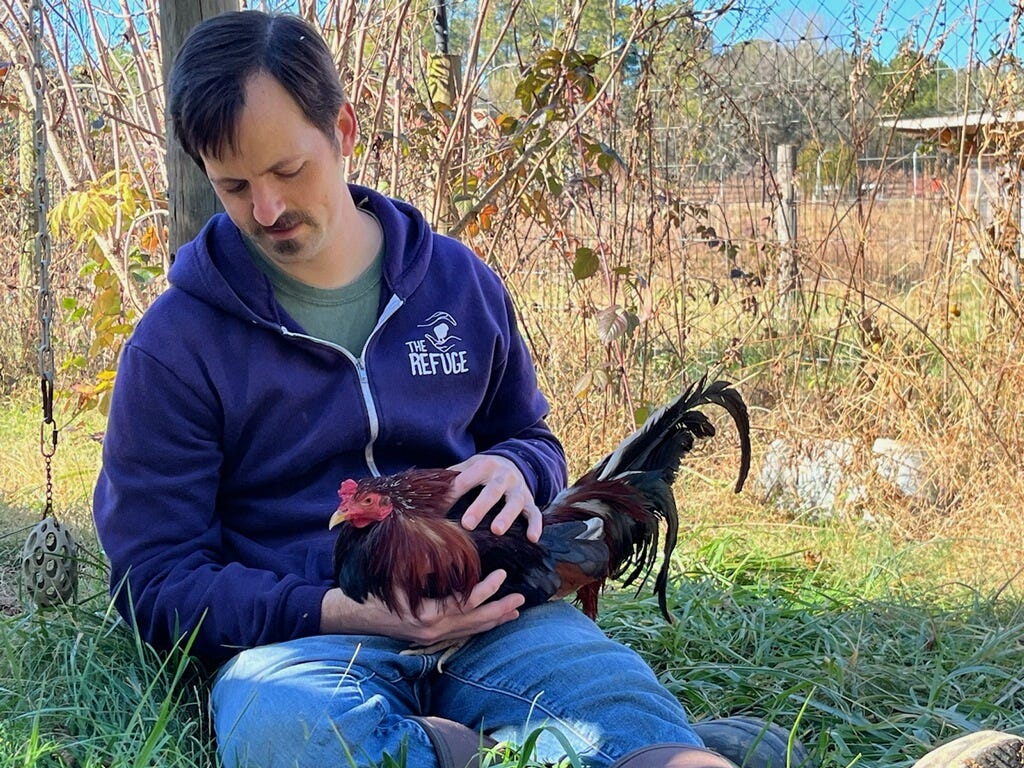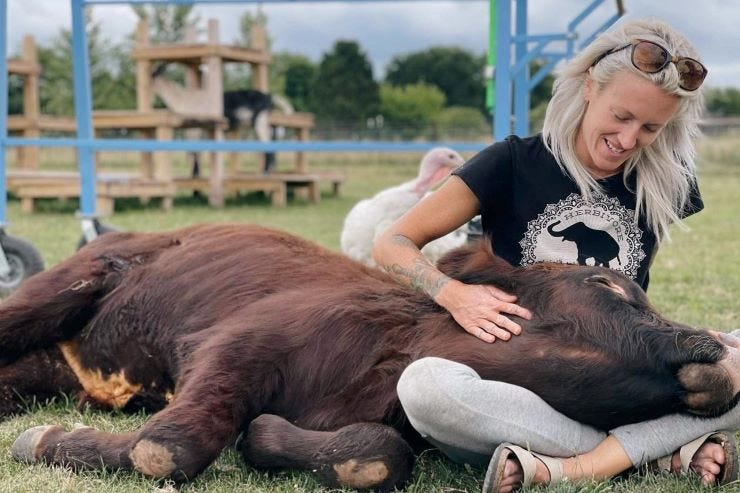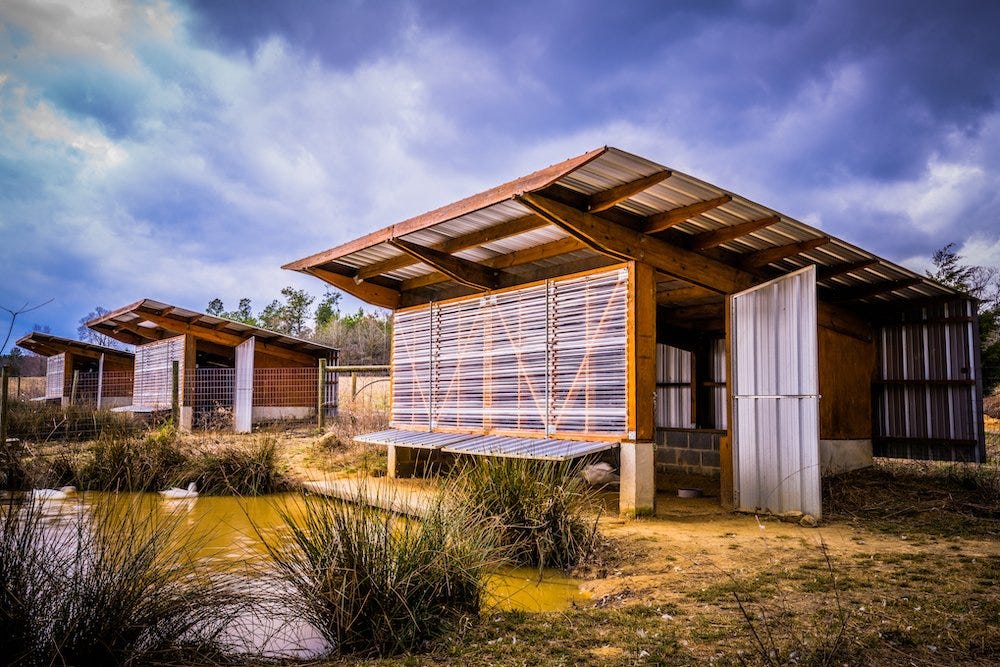Stories
Stories shape our lives. Tales of gods, nations, iPhone vs Android, a proper British breakfast, money, fashion, and so many more stories. Humans are social creatures, so we naturally socialize stories to shape and influence individual lives along with whole societies. We relate and rally by stories. We divide and fracture by stories. The stories we tell can be important. Surely you heard a story previously in your life that fundamentally changed you? A story so powerful you knew life would never be the same.
At farm animal sanctuaries, we tell stories. Stories of rescues, origins, hardships, families, kindness, and love. These stories touch everyone who visits farm animal sanctuaries. The stories told are crucial to show the public how animals should be treated and how life should be lived. Sanctuaries are catalysts for the change we wish to see in a world where all beings are respected and free from harm.
Stories told at sanctuaries forge connections with people to animals they normally never experience such as turkeys, cows, and pigs. This connection is the main power of farm animal sanctuaries. The lived experience of meeting a happy and healthy turkey for a typical urban-dwelling family is a unique advantage that sanctuaries have that no other animal liberation organization can give. For all the great work various organizations and communities do for the animals, none can offer what it feels like to spend the afternoon with rescued farm animals and hear their stories.
Farm animal sanctuaries give safe, forever homes to animals that are typically farmed which include, but are not limited to, chickens, turkeys, cows, ducks, and pigs. These organizations are non-profits, donor and volunteer-driven. They are the opposite of animal agriculture. Animal agriculture seeks to maximize profit from animals to make money while farm animal sanctuaries take donations to create comfort and peace for the animals.
Three Primary Goals
Farm animal sanctuaries have three primary goals: give care to animals, promote veganism, and foster community. Note these three mission goals are what I believe farm animal sanctuaries should strive for, not what every farm animal sanctuary believes or does in practice.
Giving Care to Animals
This is basic and straightforward. Animals neglected, abandoned, or rescued directly from farms need somewhere safe to live. These are domesticated animals that cannot survive on their own.
The problem is there are estimations that 70+ billion land animals are brought into existence every year for human use and consumption. Should the world magically go vegan overnight, we could not handle the level of care required for these animals to live out their lives happily. This problem is so large and central to the decision-making of farm sanctuaries that it will be referenced throughout this article as the Care Problem. Hence, due to the Care Problem, any sanctuary wanting to help farm animals should be promoting a future where these animals are no longer being bred into existence. Farm animal sanctuaries should be working to make farm animal sanctuaries obsolete due to there being no more farm animals. That is, sanctuaries should be promoting veganism.

Promoting Veganism
Connecting the public to farm animals is key to promoting veganism at a farm sanctuary. Connecting people to farmed animals is a sanctuary's competitive advantage over other animal rights organizations where animals are only shown in pictures or videos or talked about in literature.
Over the years I have spoken with hundreds of volunteers and over a thousand people at my sanctuary’s tours and events. I cannot count how many times I have heard comments similar to:
“I’ve never seen a turkey, let alone had one sit in my lap!”
“I never knew chickens had so much personality as individuals.”
“I thought all goats were mean.”
Extremely few people witness the life of a farm animal in an ideal environment like a sanctuary. When they do, they form a bond with the animals. Nobody at my sanctuary meets Elliot and forgets about him. Once the bond is formed, we tell guests (assuming they are not vegan) how their non-vegan lifestyle harms the animals they now care for. “By drinking dairy milk, these mothers would not have grown up with their children. Since their child was male, he would have been disregarded or used for veal.” Or “The sheep you are hugging was mutilated by the farmer that owned them by cutting off her tail before we were able to rescue her.” Or how the rooster falling asleep in their lap has no place in the egg industry since he cannot produce eggs.

Connecting people to animals so they see animals as individuals (as many people already do with cats or dogs) is the primary tactic for vegan outreach at a sanctuary. We tell the stories of the animals to override existing narratives people hold about farm animals. We provide opportunities for the public to experience animals closer to their natural environment and at their best. We provide a glimpse into a world focused on compassion and respect.
These stories are effective since most people visiting the sanctuary want to be there. They are not cornered on the street to watch horrific gore videos and talk to a stranger nor can they easily scroll past a post on social media. They choose to come out. Borrowing a concept from LGBTQ activism, on the Spectrum of Allies, sanctuary goers are closer to the left meaning they are more open to the message.
Foster Community
Another constant I hear from volunteers and guests is “I’ve been vegan for X years and have not met another vegan.” I tell them we are all right here. Between day-to-day volunteering, potlucks, tours, parties, vegfests, we all find community among like-minded individuals. Such a community can be elusive to find on one’s own, and for others, impossible. Most animal rights groups rarely have a central location to meet for casual events.
Faunalytics’ survey suggests a large reason vegans stop being vegan is the lack of social support. Imagine (or perhaps you don’t have to) being the only vegan in your family while your family tirelessly ridicules you for your decision. This can be a lot, even too much, for some folks to handle. Not having genuine community support when family, friends, and coworkers do not understand or care about veganism can drive some vegans back to conforming to the norm of society. And that is back to using animals. Some ex-vegans quit for other reasons such as health concerns where a vibrant community of knowledgeable and supportive vegans could have addressed those health concerns.
Beyond curing isolation and lowering the probability of slipping back into exploiting animals, community events are great for new ideas. Someone always has a suggestion on how we could engage more people or do something different to make the event more fun or how to do some work-related process more efficiently. Sanctuaries working in isolation cannot benefit from the expertise and creativity of community members.
Effective Farm Sanctuaries
Not all organizations are created equal. Not all farm sanctuaries work hard on the three main focus areas. We are on a mission to eliminate the suffering and exploitation of billions of animals (trillions when including fish) who have no voice for themselves. It is easy to be caught up in the emotions when dealing with the individuals in front of us, but we must remember there are thousands of sheds crammed full of similar individuals who will never experience any of the good things sanctuaries offer. We owe it to those we will never meet to ensure what we are doing is effective.
I believe a life full of extreme suffering is not a life worth living. We know there is no escape from the horrific conditions the majority of farm animals experience. And if there was, the Care Problem gets in the way. Therefore, stopping farm animals from being bred into exists counts as a life saved in the context of the work we do. So while directly rescuing and giving care to animals saves them, creating vegans saves animals as well because of the reduction of future animals who will not be brought into existence to live a life of misery and pain.
An effective farm animal sanctuary seeks to maximize the three core areas to save as many individuals as possible. What does this look like?
Animal Care
Effective animal care can take a variety of forms:
Animals should not only be safe, but their environment should be stimulating. Homes should be spacious and full of enrichment. The environment should be built around what animals would want. For example, Farm Sanctuary researches what makes farm animals happy and Piedmont Farm Animal Refuge promotes animal-centric design for the animal’s homes instead of traditional barns. Building the best lives for rescued animals is a creative task that inspires others to view these animals differently. Ensuring our animals are happy and healthy helps in building connections between the public and the animals.
Animals rescued directly from farms (think “stolen”) need safe homes. While this is risky for sanctuaries, it provides opportunities to gain more publicity if the rescue is an open rescue and build partnerships with other organizations by actively helping in direct action. For example, the Simple Heart Initiative is seeking to expand the number of open rescues. An open rescue is one where activists go into a factory farm without face covering, show themselves rescuing animals, and bring them to safety. The animal gets life in a sanctuary while their story is maximally exposed to progress the movement.
Promoting Veganism
Effective farm animal sanctuaries should work towards promoting veganism with similar rigor and earnestness as pure animal liberation and vegan organizations. Effective sanctuaries should seek to talk to as many non-vegans as possible. Some examples:
Tours
Local and digital papers, magazine articles, and interviews
Podcasts
School field trips
Corporate or organization volunteer days
Tabling events at local festivals
Cooking, art, yoga, etc. classes
Benefit concerts
Guest speakers at any event that would take you (vegan clubs, environmental groups, health groups, LGBTQ events, etc.)
Host vegfests, potlucks, food trucks, etc.
Lively social media, YouTube, documentary-style videos
The list can go on. The core idea is to use a sanctuary’s unique ability to connect people to farm animals as maximal as possible. Almost any event type to bring people out to the sanctuary or bring the conversation of animal sanctuaries to them is a win.
The work at a sanctuary is never-ending. Taking care of animals properly is a large job. Sanctuary staff and board of directors constantly judge how to allocate funds and priorities: take in more animals or spend more time on outreach? I have no special formula to figure this out, but I suspect as time goes on and the sanctuary gets more popular, the fewer animals one should take in. Constant expansion of land and animals acquired has diminishing returns. How many cows should be directly saved to help promote veganism which will lower the number of new cows coming into existence? Taking in five more cows is not cheap. This cost would be worth it if your current count of cows is zero, but what if you already had twenty? Perhaps that money could save more animals if it went to hiring a staff person to do outreach, events, education, etc.
Community
Where vegan outreach is about engaging with the non-vegan public, community building here refers to the vegan community. There is a lot of crossover with the outreach section because many outreach activities require folks committed to the sanctuary. Events like potlucks and vegfests will often involve the vegan community along with the non-vegan public. After a morning of working at the sanctuary, sit down and have a mini-potluck. This small gesture helps people feel connected. Effective sanctuaries should seek to foster and build a strong community around them.
If a sanctuary has the space, they could give aid to other organizations as a meeting place. This is a great example of solidarity with other organizations working towards similar goals.
Conclusion
These are examples based on my thoughts and experience at multiple sanctuaries. You might have other community ideas. There might be unique events in your area that your sanctuary should be a part of. I would love to hear other ideas on how farm animal sanctuaries can be more effective since new sanctuaries are constantly popping up. Given the amount of money and time required to run a sanctuary, we need to ensure we are promoting the very best sanctuaries to create the change the animals so desperately need.





